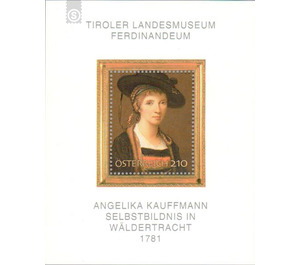painting Angelika Kauffmann Self-portrait - Austria / II. Republic of Austria 2007
Theme: Art & Culture
| Country | Austria / II. Republic of Austria |
| Issue Date | 2007 |
| Edition Issued | 420,000 |
| Item Type | Block |
| Chronological Chapter | OOS-OE2 |
| Chronological Issue Number | Block 39 |
| SID | 487466 |
| In 45 Wishlists | |
With the selfportrait of Angelika Kauffmann, created around 1781, the Austrian Post presents one of the most important painters of the 18th century. On the occasion of the 200th anniversary of her death, the state of Vorarlberg and, in particular, Schwarzenberg in Bregenzerwald, the artist's hometown, dedicate an extensive exhibition to her. Angelika Kauffmann, born on October 30, 1741 in Chur, spent her childhood at Lake Como and showed early on her extraordinary talent for painting. After the death of the mother, the father moved to Schwarzenberg, from which came the family Kauffmann paternal. There he was expected to redecorate the church destroyed by fire. The sixteen-year-old Angelika supported her father and painted the twelve apostles in fresco technique after copperplate templates of the Venetian painter G.B. Piazzetta. Angelika Kauffmann traveled extensively with her father. For her artistic training she went to Italy, where she studied copying the technique of old masters. She received public recognition as a member of the Accademia di San Luca. For her, a 15-year stay in London has become a period of rich work and social success. She excelled especially with her portrait painting. Through her influential patron, the painter Joshua Reynolds, she was in contact with many important personalities. She was the only woman among the 22 founding members of the Royal Academy in London. After a failed marriage, she married the Venetian painter Antonio Zucchi and went with him to Italy. After the death of her father, she settled in Rome. Her studio became the meeting place of important art lovers. Also Goethe and Herder were among their prominent admirers. Angelika Kauffmann died on November 5, 1807 in Rome. Her grave is in the church of San Andrea della Fratte. Portrait jobs formed life's main part of Angelika Kauffmann's work. But also in the field of history painting with mythological, allegorical and religious themes, she enjoyed high reputation. She received orders from dynasties, nobles and important contemporaries. Great influence on her painting style and on her conception of art came from her acquaintance with the German antiquarian Johann Joachim Winkelmann in Rome. Classicistic elements paired with a rococo-light color application are the characteristic features of her sensitive style. Angelika Kauffmann, the "perhaps most cultured woman in Europe" (J. G. Herder), gained international recognition far beyond the borders of her homeland.


